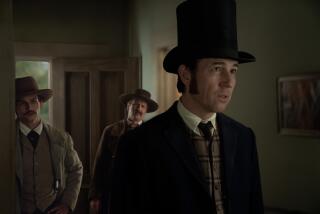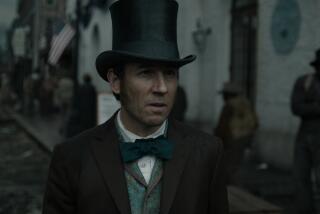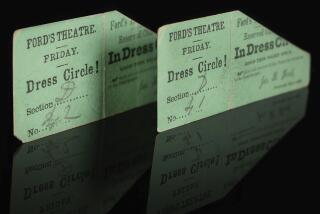In Mary’s footsteps
Mary Todd Lincoln brought psychics into the White House 120 years before Nancy Reagan did. She defined what it was to be a shopaholic long before Kim Kardashian knew what a gold card was. And if the rumors are true, she beat FDR, JFK and Bill Clinton to the commit-adultery-while-in-the-White-House punch. Then there was that little stint in what was then called the “lunatic asylum.”
On the other hand, Mary Lincoln was a brilliant political strategist, the one person who believed her husband was presidential material and the first president’s wife to be called first lady.
But in the space of a decade, the press went from calling her “amiable and accomplished” and a “sparkling talker” to describing her as a “mercenary prostitute . . . who had discredited her sex and injured the name . . . of her country and husband.”
No wonder I wanted to write a novel about this woman.
Of course, historical fiction is, after all, historical. So the three years I spent writing “Mary,” I traveled to every historical site Mary Lincoln called home. Including that asylum. This year, with the 200th anniversary of Abraham Lincoln’s birth coinciding with our new president’s fascination with all things Lincoln, it seemed like a good time to revisit the places where the country’s “first” first lady saw dead people, practiced retail therapy and (possibly) played around behind Abe’s very tall back.
Lexington, Ky.
Mary was born into a politically prominent, slave-holding family in Lexington. (Apparently, her father’s antislavery sentiments did not extend to his own slaves.) In 1832, the Todd family, which by then included the stepmother who nicknamed Mary the “Limb of Satan” and the half-brothers who would later -- somewhat embarrassingly for the wife of the Great Emancipator -- join the Confederate Army, moved into what is now known as the Mary Todd Lincoln House.
The elegant 14-room residence on West Main Street has been restored and looks much as it did during Mary Lincoln’s time. Not surprising, because much of the furniture and all of the family portraits have been donated by the Todd and Lincoln families.
The house is where Mary and her family were quarantined for three weeks during Lexington’s cholera epidemic of 1833. And during Mary’s time, it was not uncommon for families to hurl the bodies of its victims out the window to avoid infecting anybody else inside.
Springfield, Ill.
You can’t throw a stovepipe hat in Springfield without hitting a plaque informing you that Abraham Lincoln ate, slept, worked or just breathed oxygen in this spot. Some of the historical buildings are long gone. The plaque for the Globe Tavern, the boardinghouse where Mary gave birth to the son who would eventually commit her to an asylum, stands in front of a parking lot. But the Lincolns’ family home, and most of their Springfield neighborhood, are intact and restored.
Inside, the Lincoln Home looks as if the family, which for most of the time they lived here included three sons and the dog, Fido, has just run out to the 1850s version of Target. The house is full of either real, or replicas of, items the Lincolns owned. And it’s easy to stand in the family sitting room and imagine Mary behaving, as Lincoln’s law partner, William Herndon, described it, “like a toothache, keeping her husband awake to politics day and night.”
Springfield is also home to the Abraham Lincoln Presidential Library & Museum, which feels like something dreamed up by Doris Kearns Goodwin by way of Walt Disney. Yes, there are historical artifacts -- some of Mary’s jewelry, Lincoln’s eyeglasses. But there are also wax figures displayed in re-created scenes from the Lincolns’ lives, so walking through the exhibits is part history lesson, part reality show.
Washington, D.C.
Apparently the James Buchanans were slow to move out of their presidential quarters, so, like the Obamas, the Lincolns spent the weeks before the inauguration at a Washington hotel.
For the Lincolns, it was the Willard, which has recently been renovated and restored and is now the preferred property of those who prefer to sleep close to the seat of power -- the Willard is two blocks from the White House.
Although I have no evidence of this -- paparazzi were scarce in 1861 -- I believe Mary used the Willard as a trysting place to meet her lover, acting Commissioner of Buildings William Wood. True or not, the notion of a first lady straying is so refreshingly original, just staying at the possible site of her betrayal feels scandalous.
When Mary Lincoln moved into the White House, her cousin, Lizzie, described the place as “seedy and dilapidated” and claimed that the curtains looked as if they “were unchanged from George Washington’s day.”
Not requiring any actual reason to shop, Mary set about redecorating her new digs. Unfortunately, her taste was too good. And her impulse control too weak. The new first lady so overspent her $20,000 budget that Congress had to approve a Mary Lincoln bailout.
Tours of the White House can be arranged through your member of Congress, usually six months in advance. If you do score a ticket, be sure to listen for emanations from the Red Room. It’s here that Mary and her fellow spiritualists would gather for their “magnetic circles.”
There’s something unsettling about listening to the story of Lincoln’s assassination when you’re standing a few feet from where it happened. Ford’s Theatre has undergone a restoration, including the presidential box where the framed portrait of George Washington still bears the nick made by the assassin’s spur and where the dashing, and probably drunk, John Wilkes Booth shot Mary’s husband in the head.
Batavia, Ill.
This commuter town, a 20-minute train ride from Chicago, was the site of Bellevue Place sanitarium, an asylum for women who, as the sanitarium’s advertisements put it, were neither “syphilitic nor furiously mad.” It’s here Mary Lincoln was sent after her eldest son, Robert, had her declared insane by the Cook County Court.
The actual Bellevue Place building still stands at 333 S. Jefferson St. and looks very much the same from the outside. These days, however, the rooms that once housed deranged women have been converted into condos.
If you want to see what the inside of Bellevue Place sanitarium looked like before condo-ization, go to the Batavia Depot Museum. One of the showpieces of this small museum is a re-creation of the room in which Mary was locked every night.
In Mary’s time, treatment at Bellevue Place consisted of salt baths and bland food, as well as opium, morphine, cannabis and eggnog generously laced with whiskey. None of these remedies for insanity is currently available at the museum. But if you make prior arrangements -- and wear a pair of white gloves -- the staff will let you page through the books of handwritten doctors’ notes.
-
--
(BEGIN TEXT OF INFOBOX)
Historical locations
LEXINGTON, KY.:
Mary Todd Lincoln House: 578 W. Main St., Lexington, Ky.; (859) 233-9999, www.mtl house.org
SPRINGFIELD, ILL:
Lincoln Home National Historic Site: 426 S. 7th St., Springfield, Ill.; (217) 492-4241, www.nps .gov/liho/index.htm
Abraham Lincoln Presidential Library & Museum: 212 N. 6th St., Springfield, Ill.; (800) 610-2094, www.presidentlincoln.org
WASHINGTON, D.C.:
The Willard: 1401 Pennsylvania Ave. NW, Washington D.C.; (202) 628-9100, www .intercontinental.com
The White House: 1600 Pennsylvania Ave. NW, Washington, D.C. To arrange a tour of the White House, contact your local congressional representative. Plan at least six months ahead of your visit.
Ford’s Theatre: 511 10th St. NW, Washington, D.C.; www.fordstheatre.org
BATAVIA, ILL.
Bellevue Place sanitarium: 333 S. Jefferson St., Batavia, Ill. (private)
Batavia Depot Museum: 155 Houston St., Batavia, Ill.; (630) 406-5274, www.batavia historicalsociety.org
More to Read
Sign up for our Book Club newsletter
Get the latest news, events and more from the Los Angeles Times Book Club, and help us get L.A. reading and talking.
You may occasionally receive promotional content from the Los Angeles Times.








